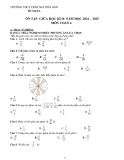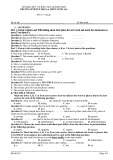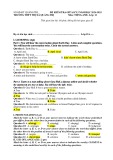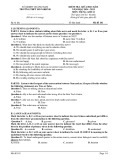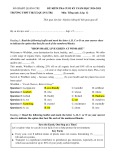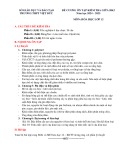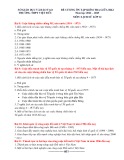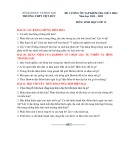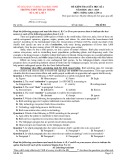
1
Trường THPT Ngô Gia Tự ĐỀ CƯƠNG ÔN TẬP GIỮA KÌ 2 MÔN TIẾNG ANH 12
Tổ: Tiếng Anh NĂM HỌC 2024-2025
A. CONTENTS:
1. Grammar: Unit 6 -->8
- Tenses: Past simple and past continuous, simple present and present continuous, present perfect, simple future
- Active and passive causatives
- Adverbial clauses of manner, result, condition and comparison
- Prepositions, articles
- Relative clauses and reduced relative clauses
2. Vocabulary: Words and phrases related to Unit 6 --> 8
3. Reading: Topics related to Unit 6 -->8
B. EXERCISES
PRACTICE TEST 1
Read the following advertisement and mark the letter A, B, C or D on your answer sheet to indicate
the option that best fits each of the numbered blanks.
MAKING FRIENDS IN THE SKY
“Who will I sit next to? Will they be interesting or will they be really
(1) ______? ”Are these the questions
that you often ask yourself before a (2) ______? But that’s all going to change! An airline company has
introduced a new system (3) ______ ‘Meet & Seat’. Now you can choose your ‘next-door neighbour’. When you
book (4) ______ tickets, you can show your social media profile to everyone on the plane. You (5) _____
everyone else’s profile. Then you can choose who you want to sit next to. (6) ______ you want to talk about
work and make business contacts, look at people’s professional network profiles. And if you prefer to have fun
and chat about travelling and shopping, look at their social network profiles!
Question 1: A. boring B. bored C. boringly D. boredom
Question 2: A. journey long plane B. plane long journey C. long journey plane D. long plane journey
Question 3: A. which called B. calling C. was called D. called
Question 4: A. her B. your C. his D. their
Question 5: A. would also see B. will also see C. were also seen D. were also seeing
Question 6: A. Like B. As if C. If D. As though
Read the following leaflet and mark the letter A, B, C or D on your answer sheet to indicate the
option that best fits each of the numbered blanks.
MAKE A DIFFERENCE - VOLUNTEER TODAY!
Let’s look at how volunteering can change lives and improve our community.
Facts and Figures:
Did you know (7) _____ millions of people volunteer every year? Volunteers help in hospitals, schools, animal
(8) _____, and community centers. They bring people together, improve lives, and support those in need. Studies
(9) _____ that people who volunteer feel happier and more connected to their communities.
Positive Actions!
Find a cause you care about. (10) _____ it’s helping children, protecting the environment, or caring for
animals, there are many ways to get involved.
Start small and be consistent. Even a few hours (11) _____ month can make a big difference.
Volunteering regularly helps build trust and strong connections with those you help.
Learn new skills and meet (12) _____ people. Volunteering is a great way to gain experience and make
friends, all while helping others.
Question 7: A. which B. that C. whom D. who
Question 8: A. buildings B. shelters C. accommodations D. apartments
Question 9: A. point out B. look up C. go over D. give up
Question 10: A. Although B. Because C. Whether D. Until
Question 11: A. aB. an C. the D. No article
Question 12: A. another B. the other C. others D. other
Mark the letter A, B, C, or D on your answer sheet to indicate the best utterances or sentences to
make a meaningful exchange or text in each of the following questions.
Question 13:





